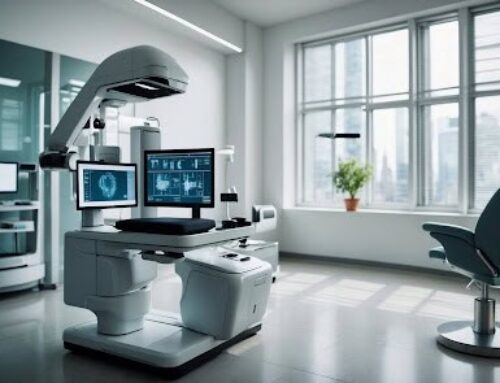Maintaining good eye health is a crucial aspect of our overall well-being, yet it’s often overlooked until issues emerge. Just as we routinely check our blood pressure or cholesterol levels, regular eye examinations should be an integral part of our health maintenance routine. Not only are our eyes the windows to the world, enabling us to experience life’s vivid colors and nuances, but they are also windows into our body’s general health.
Many systemic health conditions, such as diabetes and high blood pressure, can have early signs detectable through an eye examination. An optometrist can identify these early markers and direct patients to appropriate medical care. By doing so, we can manage these conditions at an early stage, preventing potential complications and supporting overall health.
Furthermore, with the surge in screen usage due to technology advancement and lately, the pandemic induced work-from-home culture, our eyes are subject to tremendous stress. This increased digital screen time can lead to Computer Vision Syndrome, characterized by eye strain, blurred vision, dry eyes, and headaches. Regular visits to an optometrist can help manage these symptoms effectively, ensuring you continue to enjoy good vision.
In the next section of this article, we’ll guide you through seven compelling reasons to regularly visit an optometrist for the sake of your eye health. Each subsection will be dedicated to one reason, where we delve into the various benefits, the potential risks of neglect, and how regular check-ups can make a world of difference.
1.Role of Optometrists in Promoting Eye Health
Optometrists play a pivotal role in promoting eye health, primarily through early detection and prevention of eye-related conditions. A routine eye exam is not just about checking for vision accuracy, but it also encompasses extensive tests to evaluate the overall health of the eyes. Optometrists are trained to detect subtle changes in the eye that may signify the onset of a condition, even before the patient experiences any symptoms.
Conditions such as glaucoma, macular degeneration, and ocular melanoma often have no visible signs in the early stages but can cause significant irreversible vision loss if left untreated. Regular examinations by an optometrist can detect these conditions at an early stage, enabling prompt treatment and potentially saving vision.
Moreover, optometrists play a crucial preventive role through patient education. They provide guidelines on good visual hygiene, advise on protective measures like UV-protective eyewear, and promote a diet beneficial for eye health. By doing so, optometrists actively contribute to maintaining and enhancing our eye health, reinforcing the importance of regular eye checks as part of our overall health care regimen.
2.Early Detection and Prevention
A. Regular Eye Exams: Detecting Potential Issues Before They Become Major Problems
Regular eye examinations serve as the cornerstone for early detection of eye-related issues. These comprehensive check-ups involve a variety of tests that enable optometrists to evaluate the complete health of the eyes, beyond just assessing visual acuity. From assessing intraocular pressure, dilating pupils for a thorough retinal evaluation, to checking the eyes’ alignment and movement, these tests provide an insight into the well-being of our eyes. By identifying potential problems at an incipient stage, an optometrist can direct the patient towards appropriate treatment, curtailing the progression of the condition and mitigating the risk of severe complications.
B. Importance of Early Intervention in Preventing Vision Loss and Other Complications
Early intervention plays a pivotal role in preventing vision loss and potentially debilitating complications associated with eye disorders. Here are a few reasons why it’s so critical:
- Preventing Disease Progression: Disorders like Macular Degeneration or Glaucoma, when detected early, can be managed more effectively, preventing further vision loss.
- Preserving Quality of Life: Vision loss can drastically impact the quality of life, affecting individuals’ ability to perform everyday tasks. Early intervention helps maintain vision, preserving independence and quality of life.
- Economic Benefit: Early detection and treatment of eye diseases can reduce the need for more extensive, costly treatments in the future.
- Avoiding Vision-Related Accidents: Good vision is essential for safety, particularly while driving or operating machinery. Routine eye check-ups can identify vision impairments, prompting corrective measures and reducing risk of accidents.
- Improvement in Academic and Work Performance: For children and adults alike, untreated vision problems can impact academic performance and productivity at work. Early intervention can rectify these issues, leading to improved performance and success.
3.Prescription Updates: Keeping Your Vision Sharp and Clear
Ensuring that your eye prescription is up-to-date is more than just a matter of clear vision – it’s an essential aspect of maintaining overall eye health. Wearing glasses or contact lenses with an outdated prescription can strain your eyes and exacerbate vision problems over time. Regular eye exams allow your optometrist to fine-tune your prescription and ensure that your vision correction is as accurate as possible.
This not only helps you see the world more clearly, but also minimizes the risk of developing complications such as headaches, eye strain, and in severe cases, lazy eye. By keeping your prescription updated, you’re giving your eyes the support they need to function optimally.
4.Detection and Management of Eye Conditions: A Comprehensive Approach
Optometrists are qualified to diagnose and manage a wide variety of eye conditions. This includes not only common problems like refractive errors (myopia, hyperopia, and astigmatism) but also more serious issues such as cataracts, glaucoma, and macular degeneration. The ability of optometrists to detect these conditions early makes a significant difference in treatment outcomes, preserving vision and enhancing quality of life.
Eye conditions can vary in severity, each impacting our overall health in unique ways. For instance, dry eye syndrome, although commonly dismissed as a minor discomfort, can significantly impair daily activities if left untreated. It can lead to blurred vision, severe eye discomfort, and, in worst-case scenarios, vision loss. Similarly, age-related macular degeneration, the leading cause of severe vision loss in people above 60, can compromise independent living.
Glaucoma, known as the “sneak thief of sight,” is notorious for its absence of early symptoms, yet it can lead to irreversible blindness if not detected in time. Cataracts, on the other hand, are generally associated with aging, causing the lens of the eye to become cloudy and impairing vision. Early detection by an optometrist allows for effective management and treatment of these conditions, minimizing their impact on our overall health and well-being and maintaining our quality of life. Therefore, regular visits to the optometrist are the best defense against potential eye disorders and their systemic implications.
5.Monitoring Eye Health for Chronic Diseases: The Integral Link
Many chronic systemic diseases like diabetes, high blood pressure, and auto-immune disorders often manifest early signs in the eyes, making comprehensive eye examinations a critical tool in detecting these conditions. For instance, people with diabetes are at risk of developing diabetic retinopathy, a condition where high blood sugar levels cause damage to the blood vessels in the retina. It can lead to blurry vision and, if left untreated, loss of vision. Similarly, high blood pressure can cause blood vessel changes in the retina, leading to hypertensive retinopathy.
Optometrists are skilled in identifying these subtle changes during eye examinations which can be the first indication of such systemic diseases. If detected, they can direct the patient to appropriate health care providers for further testing and management, thereby playing a significant role in the early diagnosis and treatment of these conditions.
In patients already diagnosed with chronic diseases, optometrists play a critical role in managing eye health. In the case of diabetic patients, regular eye exams can help monitor the progression of diabetic retinopathy and facilitate timely intervention to prevent vision loss. Similarly, monitoring eye health in patients with high blood pressure can help detect hypertensive retinopathy and enable early intervention.
Thus, regular visits to the optometrist can be a crucial part of disease management for individuals with chronic conditions. Not only can these visits help preserve vision, but they can also assist in keeping track of the overall progression of the disease, providing a holistic approach to health care.
6. Digital Eye Strain Awareness: Navigating the Challenges of the Digital Age
In the age of technology, our eyes are subjected to tremendous strain due to prolonged screen exposure. This has been amplified by the shift towards a digitalized working environment, especially during the COVID-19 pandemic.
A. Impact of Increased Screen Time on Eye Health
Increased screen time has a direct impact on our eye health, leading to a condition known as Digital Eye Strain or Computer Vision Syndrome. Symptoms can include blurred vision, dry eyes, headaches, neck and shoulder pain, and difficulty focusing. Excessive exposure to screens, particularly blue light emitted from digital devices, can also disrupt our sleep patterns and contribute to retinal damage over time. These factors combined pose a significant threat to our overall eye health, with the potential to affect our productivity and quality of life.
B. Tips and Advice from Optometrists to Prevent Digital Eye Strain
Optometrists suggest several strategies to combat digital eye strain:
- 20-20-20 Rule: Every 20 minutes, take a 20-second break and look at something 20 feet away. This helps relax the focusing muscle of the eyes.
- Proper Workspace Ergonomics: Position your computer screen 20 to 24 inches from your eyes, and the top of the screen at eye level or slightly below. This can help reduce strain on your eyes and neck.
- Adequate Lighting: Ensure your surrounding light is balanced with the light emitted from your device to reduce contrast and relax your eyes.
- Regular Eye Exams: Regular eye check-ups can help detect early signs of digital eye strain and update prescription lenses if needed.
- Use of Blue Light Blocking Glasses: These glasses can help to filter out harmful blue light emitted from digital devices.
- Blinking: Blinking regularly while using digital devices can help prevent dry eyes by maintaining tear film’s natural moisture.
- Healthy Diet and Exercise: A balanced diet rich in eye-friendly nutrients (like Omega-3 fatty acids, Lutein, and Vitamins A, C, and E), and regular exercise can help maintain overall eye health.
By adhering to these practices, we can mitigate the impact of digital eye strain and maintain eye health in the digital age.
7. Overall Wellness and Quality of Life
A. How Good Eye Health Contributes to Overall Well-being
Maintaining good eye health is an integral part of our overall well-being. Optimum vision allows us to navigate the world safely and confidently, participate in activities we enjoy, and maintain independence. It’s not just about seeing clearly, but also about processing what we see. Our eyes serve as the gateway to our environment, influencing how we perceive and interact with our surroundings. They play a significant role in our cognitive function, impacting areas such as reading comprehension, attention span, and learning ability. Moreover, our eyes provide early warning signs for many systemic diseases, making regular eye check-ups a critical component of proactive healthcare. Therefore, good eye health extends beyond vision clarity—it contributes significantly to our mental, emotional, and physical health.
B. Improved Quality of Life through Clear Vision and Healthy Eyesight
Clear vision and healthy eyesight can considerably enhance our quality of life. With healthy vision, we can perform daily tasks with ease, pursue hobbies, and appreciate life’s visual beauty. For children, good eye health is vital for academic performance and social development. For adults, it supports professional productivity and allows for continued enjoyment of reading, arts, or outdoor activities. For older adults, healthy eyesight preserves independence and reduces the risk of injuries from falls or accidents. Moreover, good eye health facilitates better communication, as we rely significantly on visual cues and expressions in social interactions. Therefore, investing in our eye health is investing in a life with clear sight, enabling us to live fully and enjoy the world to the fullest.
Summing up the Importance of Visiting an Optometrist for Better Eye Health
Visiting an optometrist is not merely about correcting refractive errors or updating eyewear prescriptions. It is an essential step towards comprehensive eye care, early identification of optical and systemic diseases, and ensuring optimal visual health.
An optometrist’s expertise stretches across diagnosing and managing a wide spectrum of eye conditions, from common refractive issues to more severe problems like cataracts, glaucoma, and macular degeneration. They also play a significant role in monitoring eye health in patients with chronic diseases and advising on strategies to combat digital eye strain in our increasingly digitalized world. Therefore, regular visits to an optometrist play a crucial role in promoting our overall well-being, from enhancing cognitive function to preserving our independence and quality of life.
Moreover, The quality and functionality of eyewear largely reflect the expertise of opticians and eye doctors, serving as tangible proof of their proficiency. Opticians, with their intricate knowledge of lens technology and frame designs, can provide personalized eyewear solutions considering the specific needs and lifestyle of the patients. On the other hand, eye doctors or optometrists contribute their clinical acumen in prescribing the most appropriate vision correction. High-quality eyewear not only aids in achieving optimal vision but also enhances comfort, durability, and aesthetics. By adhering to these practices, we can mitigate the impact of digital eye strain and maintain eye health in the digital age.
Encouragement to Prioritize Regular Eye Exams for Optimal Eye Care
Preserving our vision should be a priority, not an afterthought. To ensure that our eyes remain in the best possible health, we need to commit ourselves to regular eye examinations with a qualified optometrist.
Remember, your eyes are your windows to the world, and taking care of them means safeguarding your ability to take in life’s most beautiful sights. Every eye exam is an opportunity to catch potential issues early and keep your vision clear and sharp. Therefore, let’s pledge to prioritize our eye health, understand the importance of regular eye exams, and take action today for a clearer tomorrow.








